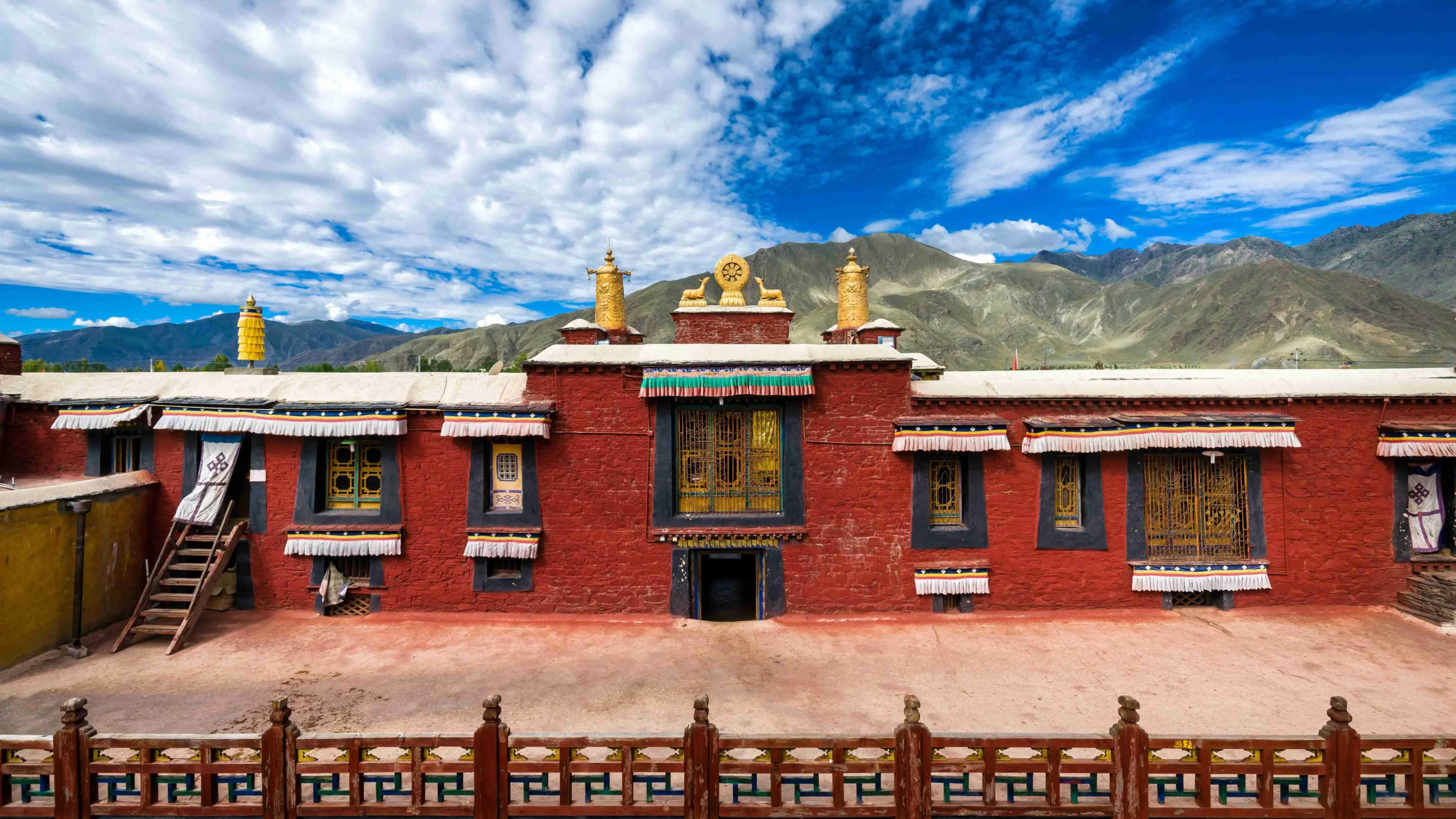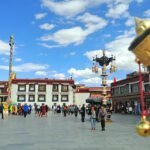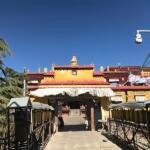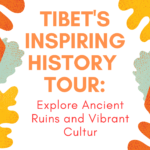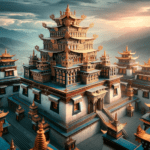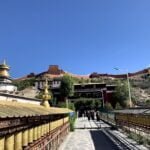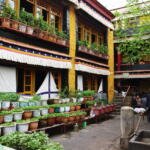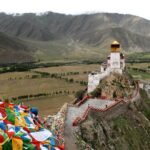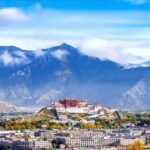Trandruk Temple, known as khy-vbrug-lha-khang in Tibetan, is a significant Buddhist temple located on the east bank of the Yalong River in Trandruk Town, Nedong County, just 5 kilometres away from Zedang Town. Recognized as a national key cultural relic protection unit, Trandruk Temple is one of the earliest Buddhist temples in Tibet, boasting a history of approximately 1,300 years.
Historical Significance of Trandruk Temple:
- Establishment: The temple was built during the reign of Tibetan King Songtsen Gampo, dating it back over a millennium, making it a crucial site in the history of Buddhism in Tibet.
- Mythological Association: According to legend, Princess Wencheng used astrological calculations to determine the temple’s location as a means to suppress a demon, a strategy believed to ensure the country’s prosperity.
Legends and Myths:
- King Songtsen Gampo’s Battle: The temple is associated with tales of King Songtsen Gampo, who transformed into a roc to battle evil dragons in a nearby lake. These stories symbolize overcoming negative forces for the nation’s well-being.
Trandruk Temple, steeped in rich history and mythological significance, is more than just a religious site; it is a key to understanding the early development of Buddhism in Tibet. The temple’s legends and historical background offer a window into the ancient traditions and beliefs that have shaped Tibetan culture and spirituality. For visitors and scholars alike, Trandruk Temple remains an invaluable resource for exploring the profound spiritual heritage of Tibet.
Popualr Poem of Trandruk by Songtsen Gampo
The poem narrates the legendary tale associated with Trandruk Temple (khy-vbrug-lha-khang), highlighting the heroic acts of Tibetan King Songtsen Gampo and Princess Wencheng. This mythological story is central to the temple’s historical and cultural significance in Tibet:
Songtsen Gampo was skilled in martial arts,
A warrior king of great heart.
Princess Wencheng, wise and clever,
Together, they would face a daunting endeavor.
In Boyu, Trandruk Temple was to rise,
To quell a demon beneath the skies.
In the lake, five dragons strange,
A threat so dire, the land to change.
To the Great Sage, they prayed for aid,
To banish trouble the demons made.
Songtsen Gampo, with courage bold,
Fought the dragons, brave and cold.
Transformed into a mighty roc,
He soared above to the mountain's top.
In five fierce battles, he fought with might,
And the dragons vanished from sight.
To suppress the dragon beneath the land,
He filled the soil with his own hand.
Trandruk Temple, thus he named,
For the roar of his victory, widely famed.
The harrier's cry, like a dragon's call,
Echoed as the demon did fall.
A temple now stands, a sacred place,
A testament to their grace and grace.
This poem encapsulates the essence of the legend surrounding Trandruk Temple, emphasizing the historical figures of Songtsen Gampo and Princess Wencheng. Their combined efforts to defeat the dragons and establish the temple have been immortalized in Tibetan culture, symbolizing the triumph of good over evil and the protection of the land. The temple, named for the victorious roar of Songtsen Gampo, remains a significant spiritual and historical site, embodying centuries of Tibetan lore and tradition.
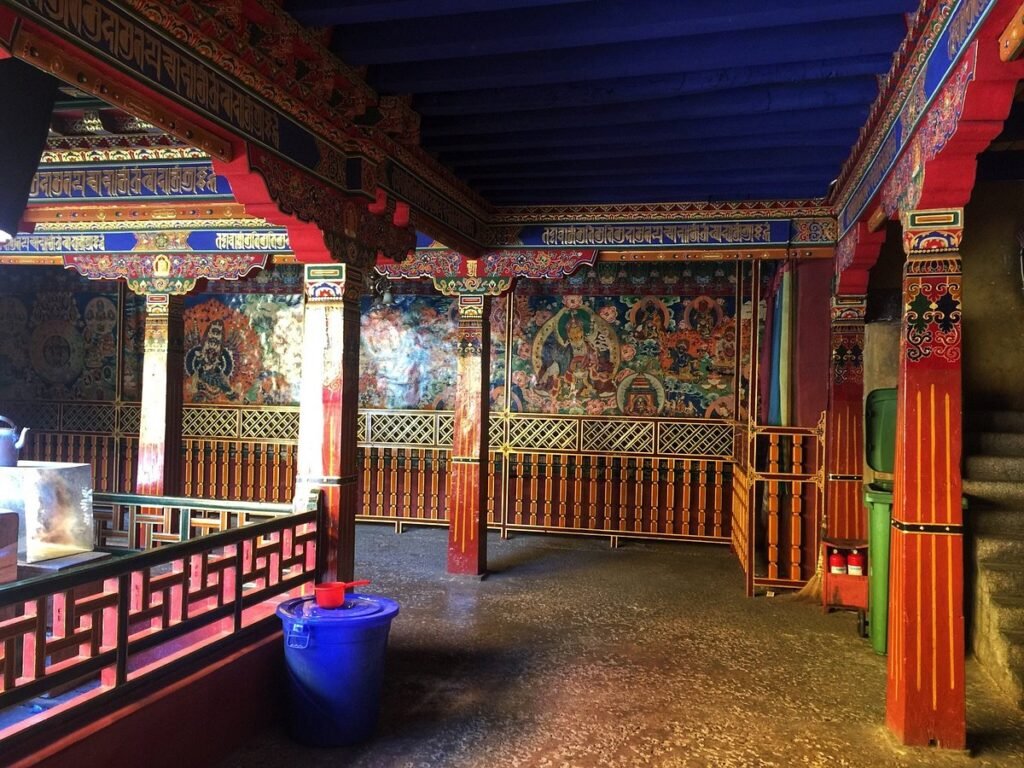

Structure and architecture of Trandruk Temple
The earliest structure of Trandruk Temple is a small hall known as “Naiding Lhakang,” positioned opposite the temple’s main building. This hall, traditionally referred to as “Naidingxue” (first floor) and “Naidingdang” (top floor), spans approximately 75 square meters and is supported by six pillars. Within Naiding Lhakang, the principal deity revered is a statue of Tibetan King Songtsen Gampo. The dimensions of the hall are 10.2 meters in length and 7.3 meters in width, and it originally housed a statue of Master Padmasambhava.
Initially, Trandruk Temple was a modest structure, comprising merely a few doors and a basic layout. However, significant expansions and renovations have been undertaken over the centuries:
- Naidong Gongma Situ Bodhi Building: One of the first major expansions of Trandruk Temple, this construction cannot be dated earlier than 1351. This expansion involved the addition of more Buddhist halls, thereby shaping the temple’s layout.
- Fifth Dalai Lama’s Contributions: During the era of the fifth Dalai Lama, the temple underwent extensive renovations and additions. These enhancements included the installation of a golden dome atop the main hall, the construction of a gate tower in front of the Tsochen main hall, and the addition of the Sang A Phodrang.
These developments transformed Trandruk Temple from a small religious site into a significant and expansive temple complex, reflecting the growth and evolution of Buddhist architecture and worship in Tibet. The temple, with its rich history and successive renovations, stands as a testament to the enduring spiritual significance and cultural heritage of Tibetan Buddhism.
Later expansions
Trandruk Temple, also known as Changzhu Temple, underwent significant renovations and expansions under the guidance of the seventh Dalai Lama. These changes not only enhanced the temple’s size but also its architectural grandeur:
Expansion under the Seventh Dalai Lama:
- Size: The temple’s area expanded to approximately 4665.6 square meters, with a length of 81 meters and a width of 57.6 meters.
- Features: It now houses 21 lacans (chapels) and prayer corridors. The temple’s roof is adorned with a shining golden dome, adding to its magnificence.
- Reverence by Dalai Lamas: Following the fifth Dalai Lama, successive Dalai Lamas have made it a practice to visit Trandruk Temple annually to offer incense and worship.
Architectural Layout:
- Courtyard: The temple is divided into two main sections. The front part features a small courtyard, while the rear houses the Lakang compound with the Tsochen Hall at its centre.
- Bronze Bell: A notable feature is a bronze bell at the entrance, dating back to the 8th century, showcasing the historical ties and cultural exchanges between Tibet and other regions. This bell, with Tibetan inscriptions, was cast under the supervision of the Han monk Renqing (Dabao).
Sang A Phodrang:
- Construction Era: Built in the late 17th century by the Nyingma sect.
- Purpose: Designed to accommodate Nyingma monks during visits by the Dalai Lama.
- Facilities: Includes teahouses, firewood sheds, warehouses, living quarters, and kitchens.
Inner Structure:
- Lakang Courtyard: The main building of the temple, features a tall porch and is connected to the prayer cloister.
- Deity Statues: The entrance is guarded by two protector god statues and flanked by four statues of heavenly kings.
- Cuoqin Hall: Following the patio courtyard, this hall is surrounded by an inner prayer corridor.
Trandruk Temple, with its rich history and elaborate expansions, remains a site of deep spiritual importance in Tibet. Its unique architectural features and the reverence it receives from successive Dalai Lamas underscore its status as one of the “Three Holy Temples,” revered in the hearts of Tibetan Buddhist practitioners.
Trandruk Temple, a revered Buddhist site, features a unique architectural layout with a series of chapels or lakhangs arranged around a transit corridor. This corridor serves as a pathway for worshippers to follow a sequential route for paying homage to different Buddhas.
Architectural Layout and Features:
- Transit Corridor: The temple has 12 Lhakhangs (chapels) distributed around the corridor, creating an organized route for worshipping.
- Support Pillars: The corridor is supported by single or ‘ten’ pillars. The design of these pillars has evolved. Initially, the base of the pillars featured raspberry-shaped stones with carved lotus petals. Later designs adopted a simpler, uncarved approach.
- Murals: The walls of the cloister are adorned with murals. The south and north walls depict Buddhist stories, while the west wall features portraits of the fifth Dalai Lama, Gushi Khan, and Diba Sangye Gyatso, likely dating back to the late Qing Dynasty.
- Tsoqen Hall: This hall is distinct in its architecture, contrasting early styles with its bright, large-bayed design.
The LaKhangs:
- Zu Lakang: The most prominent chapel, located at the rear center of the corridor. It is flanked by Qujie Lakang and Tuoqie Lakang, with all doors facing west. These three buildings are interconnected, forming a cohesive unit.
- Buddha Statues: Inside Zu Lakang, there is a beautifully cast bronze statue of the Third Buddha, surrounded by ten standing Bodhisattva statues. Also notable is a statue of Talking Tara, believed to have been brought by Songtsen Gampo from Liyu.
Additional Features:
- Connecting Corridors: There are passageways linking Zu Lakang and Cuoqin halls. These corridors feature a low column in the centre, with guardian deity statues at the doorposts, characterized by their short, stout, and unusual forms.
- Pagodas: Several small pagodas are built along the corridor, adding to the temple’s spiritual ambience.
Trandruk Temple, with its intricate design and sacred spaces, is a testament to the rich history and evolving architectural styles of Tibetan Buddhism. The layout facilitates a meaningful spiritual journey for visitors, allowing them to engage sequentially with various aspects of Buddhist teachings and iconography. This temple not only serves as a place of worship but also as a cultural and historical treasure, reflecting the deep-rooted spiritual traditions of Tibet.
Trandruk Temple, steeped in history and spirituality, houses several significant chapels (Lakhangs) and statues, each with its own unique importance and artistic value.
Key Chapels and Statues:
Choejie Lakang:
- Main Statue: Enshrines Songtsen Gampo, with Princess Wencheng on the right and Princess Chizun on the left.
- Other Statues: Features a standing statue of Ludongzan and Tunmi Sambuzha. Additionally, statues of deities like the Infinite Light Buddha are present, noted for their simplicity and vivid portrayal. The statue of Princess Wencheng is particularly notable for its Tang Dynasty style.
Thokche Lakang:
- Main Statue: The central figure is the Thousand-Armed Avalokitesvara Bodhisattva, flanked by statues of side servants. The craftsmanship of these sculptures is exquisite, representing early artistic styles.
- Murals and Artifacts: The walls are adorned with murals, including depictions of Buddha Zedanrathbu. A unique feature is a stake-shaped earthen stove with basin-shaped pottery, believed to have been used by Princess Wencheng.
Additional Lakhangs:
Dajin Lhakhang: Houses an image of Sakyamuni Buddha, with Horsehead Hayagriva and Dharma Protector statues alongside.
Ruodan Lakang: Dedicated to the eleven-faced Guanyin Bodhisattva, surrounded by various pagoda paintings.
Tsepak Lhakang: Features the main statue of the Longevity Buddha, accompanied by Bodhisattva and Dharma God statues.
Desha Lhakhang: Primarily enshrines the Medicine Buddha, with walls displaying 99 Buddha statues of intricate design.
Trandruk Temple’s intricate chapels and their sacred contents provide a deep insight into Tibetan Buddhist art and iconography. The presence of historical figures like Songtsen Gampo and Princess Wencheng, along with various Buddhist deities, adds layers of religious significance to the temple. Visitors to Trandruk Temple are thus offered a rich tapestry of Tibetan culture, history, and spirituality, encapsulated within its ancient walls.
Trandruk Temple features a range of chapels (Lakangs) and statues, each with its unique significance and artistry, contributing to the temple’s rich spiritual and cultural heritage.
Happy Pearl Festival Lakang:
- Structure: The Lakang is spacious, with a central area featuring eleven statues of the Great Compassion Avalokitesvara, complemented by a Bodhisattva statue and a lotus flower statue, known for their exquisite and simple design.
- Murals: The walls of the hall are adorned with paintings of Tsongkhapa, Jia Caojie, Kezhu Jie, and other founders of the Gelug sect, adding to the spiritual ambiance of the space.
Oujin Lakhang:
- Built by: The 1st Rezhen Living Buddha.
- Layout: Divided into a front room, where a statue of Amitayus is prominently displayed, and a back room that houses a tall statue of Padmasambhava, along with various depictions of this revered figure and guardian deities.
Adjacent Lakangs:
Abalakang: Featuring a one-story-high statue of the fifth Dalai Lama, flanked by statues of Tsongkhapa and other Gelug sect founders, as well as Dharma King Atisha and previous Dalai Lamas.
Tongchui Lhakhang: Primarily enshrines Tsongkhapa, surrounded by statues of patriarchs and past Dalai Lamas.
Gongkhang (Dharma Protector Temple):
- Central Statue: A tall, powerfully crafted protector deity, characterized by its black color and claw-like hands and feet, symbolizing its potent protective power.
- Artistry: The statue is an early work, notable for its delicate yet unconventional design.
These chapels and statues play a pivotal role in the religious life of Trandruk Temple, each contributing to the temple’s status as a bastion of Tibetan Buddhism. The temple’s architectural and artistic elements are deeply intertwined with the spiritual practices and teachings of the Gelug sect, making it a vital destination for practitioners and visitors seeking to immerse themselves in Tibetan religious culture.
Trandruk Temple is adorned with various symbolic and religious artifacts, intricately woven into the architectural fabric of the temple, illustrating its rich spiritual and cultural heritage.
Key Features of Trandruk Temple:
Indian ‘Stuppet Wave’ Stone Pagodas:
- Location: Positioned at the inner ends of the north and south corridors.
- Historical Significance: These stone pagodas are believed to date back to the Songtsen Gampo period, adding a deep historical layer to the temple’s ambiance.
Padmasambhava Hall:
- Structure: This hall is accessible through three entrances and faces west, known for its intense incense aroma, indicative of its frequent use for worship and ceremonies.
- Significance: Dedicated to Padmasambhava, an important figure in Tibetan Buddhism.
Second Floor of the Main Hall:
- Layout: Features a large platform passage that encircles the patio and ceiling, with several Buddhist halls surrounding this passage.
- Dharma Protector Temple: Located to the west, housing a statue of the protector deity in a sacred cupboard, and a statue of Cangba in the corridor behind.
Front Gallery of the Temple:
Murals: The gallery displays murals showcasing various protector gods. One notable depiction is of Mahakala, adorned with a white elephant skin, holding diverse symbolic objects, presenting a formidable and awe-inspiring image.
Garju Lhakhang:
- Tantric Focus: This hall, associated with Tantric practices, features statues of protectors and a tall Kalachakra statue. It also houses unique guardian deities with four bodies, showcasing diverse and rare iconography in Tibetan Buddhism.
Trandruk Temple’s elaborate design, from the stone pagodas to the Tantric hall, reflects the deep-seated religious beliefs and practices of Tibetan Buddhism. Each element within the temple, whether it be the statues, murals, or architectural design, contributes to a comprehensive spiritual experience, offering visitors and practitioners alike a profound glimpse into the rich tapestry of Tibetan religious life and history.
In the eastern section of the second floor of Trandruk Temple lies Zhu Toulakang, a chapel divided into two distinct areas. This space within the temple embodies the rich heritage and artistic traditions of Tibetan Buddhism:
Zhu Toulakang:
- Two-Room Division:
- The chapel is split into an outer and an inner room.
- The outer room features a clay statue of Master Padmasambhava.
- The inner room houses a prominent statue of Master Tsongkhapa.
- Statuary and Artistry:
- The walls are adorned with statues of various patriarchs, totaling about 80 in number.
- These statues are notable for their vibrant colors and glass-like appearance, each over a foot tall.
Adjacent to Zhu Toulakang is Gajia Lhakang, another important part of the temple complex:
Gajia Lhakang:
- This area contains 100 clay statues of leaders from the Nyingma sect, showcasing the diversity of Tibetan Buddhist traditions.
Additional Temple Features:
- Dalai Lama’s Palace: Located to the west on the second floor, signifying the historical importance of the temple.
- Yueyuekang: A resting area for nobles, featuring a range of original instruments, including a significant bronze cymbal from the Xuande period of the Ming Dynasty.
Pearl Thangka – A Temple Treasure:
- The Pearl Thangka is a magnificent and valuable artifact of Trandruk Temple. It is a depiction of Guanyin Bodhisattva, intricately crafted with pearls and precious stones.
- Dimensions: The thangka measures 2 meters in height and 1.2 meters in width.
- Materials: Made with 29026 pearls (weighing 26 taels), diamonds, gold, coral, turquoise stones, purple crow gemstones, sapphires, and rubies.
- Historical Significance: Created at the end of the Yuan and the beginning of the Ming Dynasty, during the Pamudlupa dynasty, and funded by Queen Nedong. It was initially presented to Tsecuoba Temple as a precious artifact.
The Trandruk Temple, with its Zhu Toulakang and Gajia Lhakang, along with the revered Pearl Thangka, serves as a vivid reminder of the rich tapestry of Tibetan Buddhism. The temple not only stands as a place of worship but also as a repository of Tibetan art, culture, and history, attracting both devotees and admirers of Buddhist art from around the world.
Trandruk Temple and its surroundings are steeped in legends and cultural narratives, particularly those involving Princess Wencheng, a figure revered in Tibetan history. Here are some insights and tips for visitors interested in the temple’s rich lore:
Legend of Princess Wencheng and Kelsang Dolma:
- Rescue Story: The tale recounts how Princess Wencheng, during her time at the temple, was rescued from the Yalong River by a local village girl named Kelsang Dolma, leading to a deep bond between them. Princess Wencheng taught Kelsang Dolma various skills, while Kelsang Dolma assisted the princess in daily tasks.
- Cultural Impact: This legend symbolizes the connection and mutual respect between Tibetan and Han Chinese cultures.
Princess Wencheng’s Influence:
- Environmental Contributions: The willow trees around Trandruk Temple are said to have been planted by Princess Wencheng herself.
- Technological Introductions: The water mill for grinding tsampa (barley flour), a staple in Tibetan cuisine, is believed to have been introduced by Princess Wencheng from Chang’an.
- Cultural Exchanges: Traditional weaving techniques and coppersmith skills are also attributed to Princess Wencheng, highlighting the cultural exchange and integration during her time.
Folk Song:
- Cultural Tribute: A local folk song praises Princess Wencheng, referring to her as “Ajie Jiasa” (the eldest sister of the Han Dynasty), illustrating the deep respect and affection the Tibetan people have for her legacy.
Tips for Visitors:
- Explore the Legends: Visitors to Trandruk Temple can immerse themselves in these stories to gain a deeper understanding of the cultural and historical significance of the site.
- Cultural Appreciation: Observing the willow trees and the water mill can be a way to connect with the historical narrative of Princess Wencheng and her contributions to Tibetan culture.
- Understanding Sino-Tibetan Relations: The stories and legends surrounding Princess Wencheng offer insights into the historical interactions and mutual enrichment between the Tibetan and Han Chinese cultures.
These legends and cultural narratives add a layer of depth to the experience of visiting Trandruk Temple, allowing visitors to appreciate not only the architectural and spiritual aspects but also the rich tapestry of history and folklore intertwined with the site.
When planning a visit to Trandruk Temple, here are some useful tips to enhance your experience:
1. Ticket Purchase and Visiting Hours:
- Admission: Tickets are required to enter the temple.
- Timing: The temple is open from 9:00 AM to 6:30 PM. Allocate around 1 hour for a thorough visit.
- Transport: You can reach the temple by taking a tourist bus from Zedang Town, chartering a car, driving yourself, or visiting it as a stop on your return from Yongbulakang.
2. Key Attractions at Trandruk Temple:
- Stone Buddha Statues: The temple houses five ancient stone Buddha statues from Gongpotri Mountain, known as the earliest naturally formed stone Buddha statues in Tibet.
- Pearl Thangka: A highlight is the Pearl Thangka, usually stored on the second floor. Access may be restricted during certain hours, but you can request a Lama to unlock the room for viewing. Additionally, admire the thangka of Sakyamuni Buddha, said to be embroidered by Princess Wencheng herself.
3. Yalong Folk Customs Park:
- Expansion: Trandruk Temple is now part of the “Yalong Folk Customs Park” or “Shambhala Folk Customs Park,” spanning an area of 21 hectares.
- Features: The park encompasses various themed areas like the Holy Land Gate, Jungle Treasure Hunt, Pastoral Pastoral, Tibetan Style, and Water Leisure Garden, among others.
- Activities: It offers a blend of dynamic and static experiences, including viewing, entertainment, and tourism services, all showcasing the rich culture of Naidong.
When visiting Trandruk Temple, immerse yourself in the blend of spiritual, historical, and cultural experiences. The temple, along with the encompassing Yalong Folk Customs Park, provides a unique opportunity to engage with the rich traditions and heritage of Tibet.

